

 The Accurate Reloading Forums
The Accurate Reloading Forums  THE ACCURATE RELOADING.COM FORUMS
THE ACCURATE RELOADING.COM FORUMS  Guns, Politics, Gunsmithing & Reloading
Guns, Politics, Gunsmithing & Reloading  Reloading
Reloading  Audette's Ladder
Audette's LadderGo  | New  | Find  | Notify  | Tools  | Reply  |  |
| One of Us |
I am sure this method of load development has been discussed at length on this forum. However, for some reason after doing a quick search I could not find many discussions. Perhaps I am using bad search terms. Anyway, tomorrow I plan on shooting my first ladder test. Here is the load set up: Savage Model 12 22-250 Powder: Varget Case: Remington Primer: WLR Bullet: .224 Midsouth 55gr Varmint Nightmare (w/canellure) I have loaded up 11 rounds from 34 gr up to 37 gr in .3 grain increments. 34 being minimum and 37 maximum according to Lyman manual. I plan to shoot at 300 yards. Is this an good distance or do I need longer range? How big of a target will I need in height? Right now, the components above are loaded at 36 grains and 2 inches high at 100 yds. | ||
|
| One of Us |
A 2' square should give you plenty of room. Probably be OK with less but why take a chance. Let us know how it works out. God Bless, Louis | |||
|
| One of Us |
1. You will need a very good spotting scope, or shorter range. In my experience using this method, 100 yds works fine. 2. Have a copy of the target on the bench. Mark shot #1, #2, etc. When finished, mark the shots on the actual target #1, #2, etc. I've used this method for years, and very seldom failed to find a pattern. I developed this method all by my lonesome, only to learn later that I was not the first. I have a background in statistics. Save all of your data. It cost you to accrue it. Have a system for filing it. A three ring binder, program, whatever, but save that data. Trust me on this. Good shooting, Brice It works! You will have better results with far less powder and shot spent. Tell us how it works for you. | |||
|
| One of Us |
I like this method. OCW As stated above the ladder method is a good one. Rusty We Band of Brothers! DRSS, NRA & SCI Life Member "I am rejoiced at my fate. Do not be uneasy about me, for I am with my friends." ----- David Crockett in his last letter (to his children), January 9th, 1836 "I will never forsake Texas and her cause. I am her son." ----- Jose Antonio Navarro, from Mexican Prison in 1841 "for I have sworn upon the altar of god eternal hostility against every form of tyranny over the mind of man." Thomas Jefferson Declaration of Arbroath April 6, 1320-“. . .It is not for glory, nor riches, nor honours that we are fighting, but for freedom - for that alone, which no honest man gives up but with life itself.” | |||
|
| One of Us |
Thank you for your replies. Looking at the weather now and if it holds out I will be shooting today. Brice - do you find at 100 yards it's harder to find the vertical dispersion than say at 300+ yards? The nice thing about shooting it at 200 or less yards is I can do it at my local range with better benches instead of in the middle of the desert with a folding table. | |||
|
| one of us |
Well this may be too late but: How accurate is your Savage? If it is accurate then 200 or 300 should be good. How much magnification is your scope? You must be able to see the target in detail. As mentioned above, your spotting scope must be able to resolve 22 cal bullet holes at 300 yards otherwise go to 200. You must be able to "plot" the holes (on a replica target that you have with you) and number them. Peter. Be without fear in the face of your enemies. Be brave and upright, that God may love thee. Speak the truth always, even if it leads to your death. Safeguard the helpless and do no wrong; | |||
|
| One of Us |
Audeette was a match shooter who was looking for an easy way to find accuracy when loading his .300 Win Mag dispensing IMR 4350 with an accuracy of about 1.5 gr +/- with an automatic dispenser. His "ladder method" showed good results when loading for one specific range only. Unfortunately pundits would have us believe it is the end all method for general load development. It is not. I fell for the pundits BS and worked the "ladder" every which way from sunday with several different rifles and cartridges. It only worked at the one specific range tested at, just as Audette developed it for. The ladder method of load development was a total waste of time and componants for general load development. For general load evelopment for across a broad spectrum of ranges. I t does you no good to find a "sweet spot" where a 1.5+/- variation will hit close together at one range (usually 100 yards with the "believers). Reason is even though those shots may hit close together with such a wide variation in velocity at one range the velocity ES will eat you up with large bullet drop at longer ranges. Most also do not consider the cone of fire. Unless you have a sub 1/2 moa rifle/load (if so then why are you working up a load?) random dispersion within the cone of fire each charge is capable of will skew the results. Fact is there is not short cut to an accurate load. Start with quality compoants, use known data and work up the traditional way will get you there with much less effort. Start 3 shot test strings over a chronograph to get you where you should be velocity wise while watching for pressure signs. With a smaller range of velocity that looks promising you can then tweak the load +/- by .1 - .5 gr using 7 - 10 shot test strings for velocity consistency (low ES) and group size. BTW; 3-5 shot test strings are not statistically sound. Best to use 7 - 10 shot test strings when tweaking the load. Also remember that the accuracy capability of your rifle/load is not the "average" group size. The cone of fire and accuracy capability is actually the largest group size you fire with say 5 three shot groups, 3 five shot groups or best is 2 or 3 ten shot groups. If using a big game rifle the cone of fire (accuracy capability) is where ten 1st shots go when fired at the same target on different days from different positions. Larry Gibson | |||
|
| one of us |
Larry: Amen Brother One of the all time great names in ballistics science Larry Sturdivan , famous for his testimony in the JFK shooting incident wrote a very important article which falls in with what you have just stated. "The Universe Is Stochastic and Nonlinear" LARRY M. STURDIVAN and , BARBARA A. B. SEIDERS Chemical Research and Development Center, Aberdeen Proving Ground, | |||
|
| One of Us |
I appreciate everyone's input and varying opinions/perceptions. Larry, the range officer I spoke to today agrees with you on this method. Unfortunately, I do not know enough to have a very educated opinion. Seems like it's about 50/50 on who believes in the ladder method and who does not. I guess as I gain more experience re-loading I will come to my own conclusion at some point. Whether it works or does not work, at least I got to get out and shoot, which is the important part, right? Below are my results from today. Seems rather random to me. I cannot pick out a pattern. Perhaps for those of you who do use this method you can help me out. I shot this 11 shot string at 200 yards with calm conditions today at around 48 degrees. The numbers above the charge weight are the order I shot them. The load data is in my original post above. Any thoughts?  | |||
|
One of Us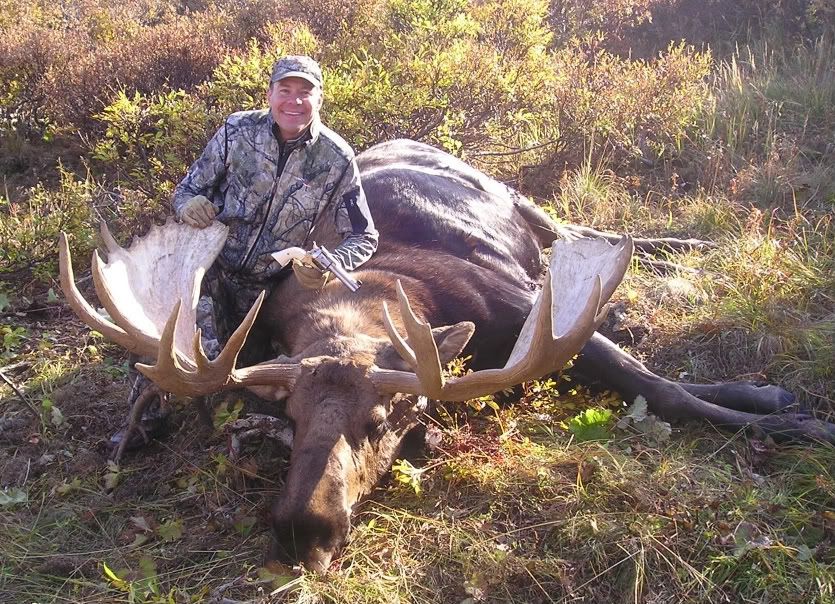 |
I've been using the Audette Ladder for some time now and totally love it. I got an advanced education when I read Jason Baney's article over on AccurateShooter.com http://www.accurateshooter.com...ge-load-development/ I probably shoot a dozen ladders per year; 5 just two weeks back. It's always best to introduce chronographed velocities into the equation but from what I see in your picture, I think you have a node with #'s 1-2-3. I usually prefer to have at least 3-shots close to each other to call it a node; or at least large enough to play within it. What is interesting to me is that some ladders go sideways, such as yours. Some climb high/right and some nearly vertical such as the ladder I shot last Summer with my 6.5x47 @ 576 yds. Shot #10's actual vel is 2908. I mis marked it. Shot #11 went over the top but that's "ok" since their was a bit of sticky bolt lift. Each shot showed a definite vertical climb or drop until #'s 8,9 and 10 which only had a 1.5" total vertical between the three; BIG NODE! Alan 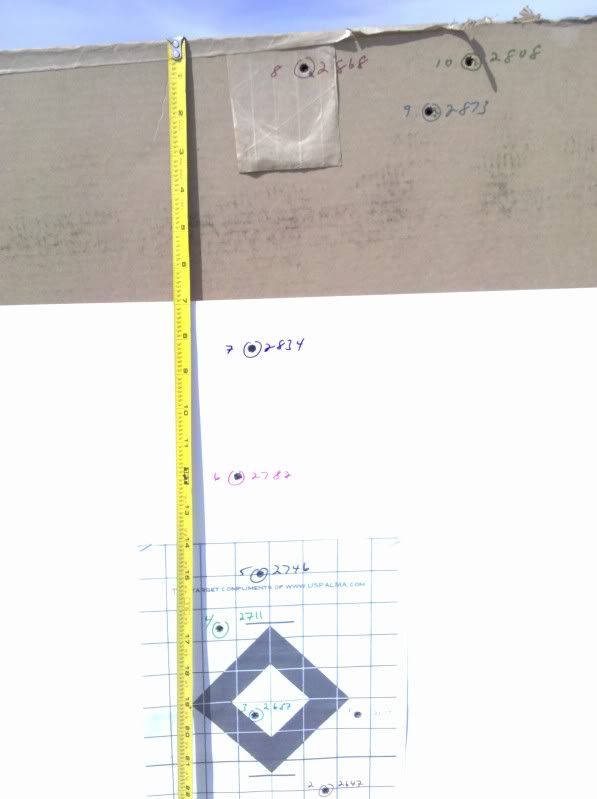 | |||
|
| One of Us |
I, fortunately, never fell for what the pundits said; after reading of your experience, I'm glad I saved my money.
Exactly.
I would add that you shouldn't exclude the so called "fliers" or "flyers" from your groups which is a favorite means people use to delude themselves into thinking the gun or load is better than it is. | |||
|
| One of Us |
DPollard, It looks to me like you learned nothing. There appears to be no significant different in the vertical component of your target, which is what the Audette ladder tests. It appears to me like a light (maybe ~5 mph difference) in the crosswind component might have caused the horizontal dispersion. What is the capability of your rifle (say an average 5 shot group at 100 yd.) under ideal (no wind) conditions? Clarence | |||
|
| One of Us |
Using Hornady V-Max 55 grain with 35 grains of Varget I can shoot 5 shots that can be covered with a dime. I'm trying out these Varmint Nightmare's because they are $40/500 instead of $35/250. Am I understanding correctly, from those who don't believe in the ladder test that it has ZERO use for finding a good node to then go back and shoot the 7-10 shot groups? | |||
|
| one of us |
I tried using the ladder about a half a dozen times at 300 yards. I never learned a bloody thing! Went back to the 100 yard range and never looked back. Graybird "Make no mistake, it's not revenge he's after ... it's the reckoning." | |||
|
One of Us |
A tea leaf reading class might be in order This is one of the five ladders I shot a few weeks back. 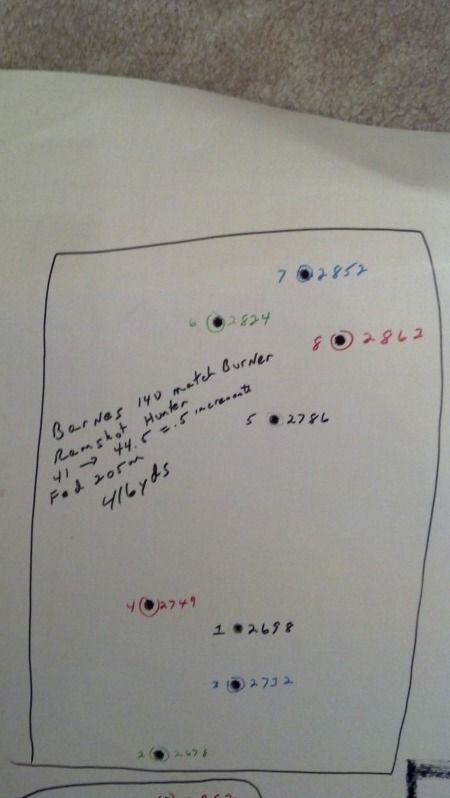 Looking at shots #5,6,7 and 8, see how they make a nice circle with the 8th shot lower than both #6 and 7; NODE. Also, look at the velocity increases; 38, 28, 10 fps. Decreasing numbers that are closer together. All this at 417 yds. So, with that in mind, yesterday, I shot some 200 yd groups bracking those 4 powder charges in .2 gr increments. I had 3, 4-shot groups that were all single digit SD's and sub 1/2 MOA. I surely won't knock anyone who has a problem with Audette's ladder. I've just learned how to read the leaves. Alan | |||
|
| one of us |
Regarding the Audette Ladder: (ILDM) Can I pose an open question here and this is a genuine attempt at trying to understand how the pundits of this method explain the physics that underlie the method: As I understand it the theory behind the Ladder method claims that the "nodes" are points of a graph where recoil motion intercedes with the occilation motion of the barrel and a "sweet spot" is found where supposedly the best groups are shot for a gradually increasing of charge mass in a series of ever increasing loads. The author of this method and it's pundits claim that "barrel whip" induced by recoil is countered by the occilation motion of the barrel at a given load mass. So my question is; For this to happen we have to accept that both motions can be plotted on a graph and somehow at some point two seperate occilitary motions intercede in the same time frame, to nullify each other which ultimataly leads to a reduction in barrel occilitary motion that in turn leads to smaller groups being shot at a specific charge mass? By this then the assumption has to follow that the occilation plotted has to be a point at muzzle of the bore, and the same goes for the plotting of a point on that barrel when looking at the recoil motion of the tip of the barrel ? Here is my problem with this theory: Recoil as an entity is a combination of two vector quantities, the first termed "primary recoil" is due to the conservation of momentum in the system. Which in terms of time on a graph is a continuum which starts with onset of projectile motion as ends with projectile egression, the second and larger quantity of recoil is due to the effect of the uncorking of the gas mass as the bullet egresses from the closed chamber/ bore system, ie the thrust enduced by the jetting of the gas mass as it leaves the bore as the projectile egresses. This is termed "secondary recoil" On a time scale this part of the total recoil which the system is subjected to is delayed relative to projectile egression, so the projectile has left the system when this action occurs. In terms of contribution this is by far the greater of the two recoils. So how then can the Audette method be accounted for by their explanation? Another point to ponder is their assumption regarding barrel time ? The assumption of this method is that for a given charge mass that velocity and thus "barrel time" is a constant number for a given charge mass. Well this is not so. We know for simple charting of velocity measured that this is simply not true. Velocity and momentum is stochastic within a upper and lower value limit for a gievn load mass. For a given load we see a dispersion of velocity values between a high and low value thus giving us a dispersion of momentum values as well and thus also barrel time values. BY this we have to then assume that when plotted on a graph barrel vibrationas a plot has to be stochastic. So in terms of a "node" on a graph this is not a fixed point but rather a shifting point for every shot fired in a string of shots loaded to the same charge mass. How is this then possible that this shifting value of barrel motion as plotted on graph for a specific charge mass fall on a equally ever changing recoil motion of the system which in turn leads to a theoretical cancelation of the two motions giving us a barrel "sweet spot" ? And above all how can it be that this can occur of recoil motion in terms of a timeline actually for the most occurs as a delayed event long after the bullet has exited the barrel ? | |||
|
| One of Us |
I would say that the problem with your ladder test is the bullets. I had mediocre accuracy with those bullets in several rifles. To do justice to a ladder test or OCW test, you need a good rifle and good components. | |||
|
One of Us |
| |||
|
| One of Us |
Grumilkin I certainly agree. A genuine "flyer" must considered as part of the group because it is telling you something. If you are good enough to "call your shot" and the flyer goes to the call then I disregard those. That's why a 10 shot test string is best because even with 1 or 2 called shots out of the group there is still enough shots with in the group to make it statistically valid. Larry Gibson | |||
|
| One of Us |
Larry, I'm not sure I follow you with the fliers. Are you saying a few fliers are OK or if you have 2 fliers then throw the load out? Yesterday I shot a 7 shot group, 5 of which were within .5 MOA and 2 were "fliers" but all 7 were just over 1 MOA. Of the 5 that were .5 MOA 3 were touching and the 2 others were touching as well. The load is 36 grains of Varget. Would you consider this a bad load? It could certainly tighten up I guess but are those fliers due to bad load or me? Here is the group:  | |||
|
| One of Us |
Why would you say that the group "could certainly tighten up"? That may be a better group than you can ever shoot again - or not. One group tells you nothing. The benchrest shooters have a much better way to determine the true accuracy of the rifle/shooter combo. Fire four 5-shot groups, count every hole. Average the groups - that is closer to what you can expect from the rifle day-to-day. Twenty 5-shot groups averaged out is even better, especially if spread out over several trips to the range. Now you have an idea what you and the rifle can do on demand. Who really cares if you shot a 1/4 moa groups once, if the average group is 1 moa? Remember that flyers can go into the group as well as out of it. . | |||
|
| One of Us |
TX NIMROD, what you say makes perfect sense to me. I think I am getting too hyper focused on 1 group. I will shoot 5-7 more shots with this load over the next few trips out and see how it goes. If it stays like this one I think I'll be happy. One thing I told myself when I first got into hand loading is I wouldn't get too preoccupied with bench rest type groups. I tend to be a perfectionist so I have fallen into this trap. I am not a bench rest shooter and really have no desire to be. I just guess I want the best groups I can get. I need to take a step back every once in a while and refocus on what I'm doing. Thanks for your reply, it truly does help me. | |||
|
| One of Us |
The whole world is filled with people who have chosen a load based on just one group. From my experience, you need at least 200 yards, with 300 yards being near ideal (and difficult for most of us to find). The "problem" with a "lot" of rifles (particularly those like the .30-06 and hotter) is that the barrel won't last long enough for you to fire off the thousands of rounds it would take to select a bullet, bullet weight, seating depth, and powder charge. Thus, it is "easy" to find a load that is very good, but you will NEVER know if you have found the perfect load. I have fired over 10000 rounds from one of my Colt 1911s, and the barrel is still sharp and clean with no visible erosion at the lede and accuracy is still excellent. | |||
|
| One of Us |
Maybe calling a flier may be valid IF you call it BEFORE you see the hole and IF you also discard other called fliers that happen to go where you wanted them to. And to DPollard... A 1 MOA group doesn't mean you have a "bad" load. Many consider a rifle that shoots 1 MOA perfectly fine for hunting and, as long as you live within the accuracy limitations I agree with them. Regarding your group, I would be measuring the holes that were furthest apart, center to center, and I would not discard any of them. | |||
|
One of Us |
The only thing I have been able to prove definitively with the Audette is that more powder produces more velocity and the POI on the target will rise. All other correlations or conclusions can be laid off to isolated incidental data from normal variations  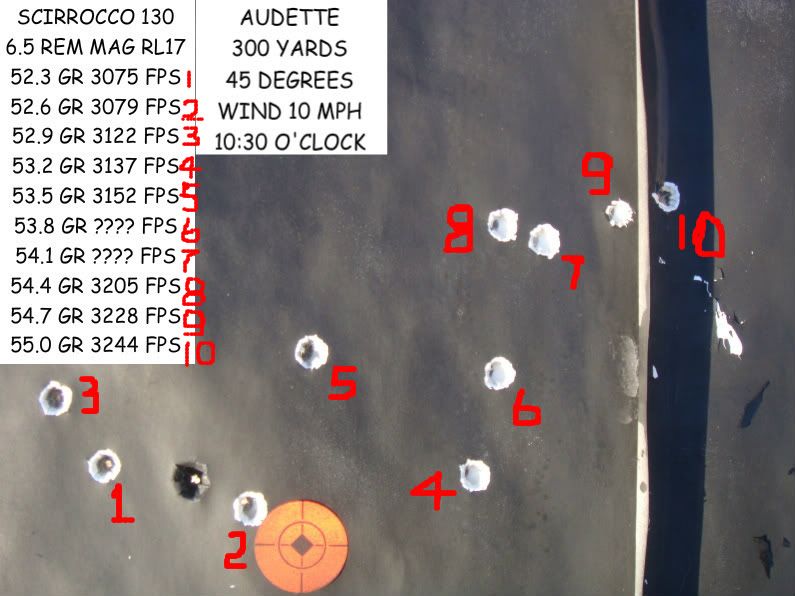 But the Audette is very useful to determine where you will find the velocity you want and whether you are approaching or exceeding max. And you are doing that the most economical way with the least amount of components by loading only ONE load at each level. Once you find the approx velocity you want and know that you are not above max then a seating depth test will demonstrate the
which is what you are looking for 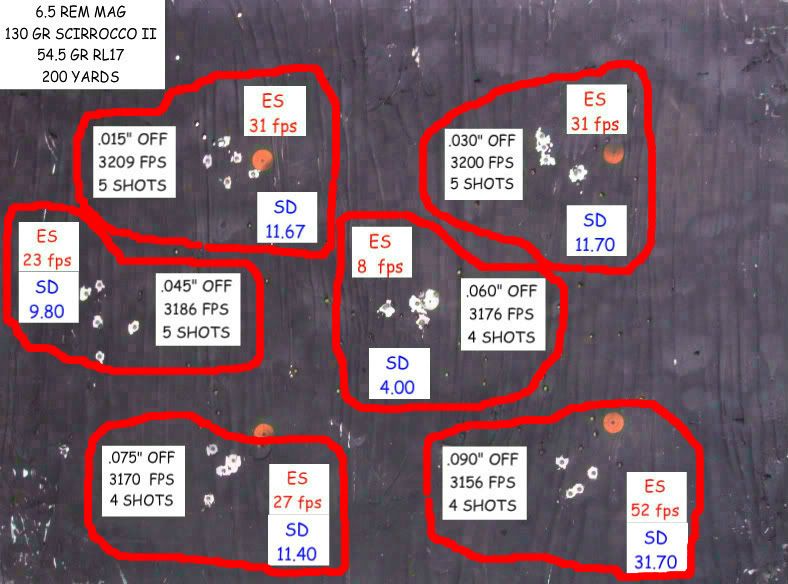 ____________________________________ There are those who would misteach us that to stick in a rut is consistency - and a virtue, and that to climb out of the rut is inconsistency - and a vice. - Mark Twain | Chinese Proverb: When someone shares something of value with you and you benefit from it, you have a moral obligation to share it with others. ___________________________________ | |||
|
| one of us |
what is the reason behind shooting a "round Robin" of groups instead of just shooting one load for group then moving to the next load and shoot a group?  Doug Humbarger NRA Life member Tonkin Gulf Yacht Club 72'73. Yankee Station Try to look unimportant. Your enemy might be low on ammo. | |||
|
| one of us |
My understanding is that the round robin takes out a few potential errors. Like change in wind during the shooting seesion, barrel heating up, barrel becoming dirty as the session progresses, etc. Graybird "Make no mistake, it's not revenge he's after ... it's the reckoning." | |||
|
| One of Us |
Grumulkin A "flyer is a shot that goes out of group on it's own. The hold was good, the sights picture was good and the trigger pull was good and there was not a shooter induced reason for the shot to go out of the group......we should not ignore that shot because it was not shooter induced and it is telling us something is wrong with the rifle or load. A "called shot" is a shot we called "bad" because of shooter induced movement where the sights were moving off the point of aim because the hold was bad, we breathed through the shot or could just not hold the rifle steady....or jerked the trigger......if the shot lands where we "called the location of the sights when the shot broke then we can ignore that shot as it was the shooters fault, not the fault of the rifle or load. Bottom line, ignore the called shots out of the group but pay attention to the "flyers" out of the group. Larry Gibson | |||
|
| One of Us |
Here is a good example of OCW results Second best 43.8 grns .725 Best load 44 grns of Varget hornady 165 GMXs .600 Third best 44.2 grns .925 (no pic) While its nice that the middle charge weight produced the best group, 1 group is simply that just 1 group. The important part is that all 9 shots of three different charge weights across 4/10s of a grain superimposed on each other print inside of 1.3 inches @ 100 yards. Also remember that charge weights are probably at best vary 1/10th of grain in consistency so we are probably talking 9 shots across 6/10ths of a grain.    Mike Legistine actu quod scripsi? Never under estimate the internet community's ability to reply to your post with their personal rant about their tangentially related, single occurrence issue.  What I have learned on AR, since 2001: 1. The proper answer to: Where is the best place in town to get a steak dinner? is…You should go to Mel's Diner and get the fried chicken. 2. Big game animals can tell the difference between .015 of an inch in diameter, 15 grains of bullet weight, and 150 fps. 3. There is a difference in the performance of two identical projectiles launched at the same velocity if they came from different cartridges. 4. While a double rifle is the perfect DGR, every 375HH bolt gun needs to be modified to carry at least 5 down. 5. While a floor plate and detachable box magazine both use a mechanical latch, only the floor plate latch is reliable. Disregard the fact that every modern military rifle uses a detachable box magazine. 6. The Remington 700 is unreliable regardless of the fact it is the basis of the USMC M40 sniper rifle for 40+ years with no changes to the receiver or extractor and is the choice of more military and law enforcement sniper units than any other rifle. 7. PF actions are not suitable for a DGR and it is irrelevant that the M1, M14, M16, & AK47 which were designed for hunting men that can shoot back are all PF actions. 8. 95 deg F in Africa is different than 95 deg F in TX or CA and that is why you must worry about ammunition temperature in Africa (even though most safaris take place in winter) but not in TX or in CA. 9. The size of a ding in a gun's finish doesn't matter, what matters is whether it’s a safe ding or not. 10. 1 in a row is a trend, 2 in a row is statistically significant, and 3 in a row is an irrefutable fact. 11. Never buy a WSM or RCM cartridge for a safari rifle or your go to rifle in the USA because if they lose your ammo you can't find replacement ammo but don't worry 280 Rem, 338-06, 35 Whelen, and all Weatherby cartridges abound in Africa and back country stores. 12. A well hit animal can run 75 yds. in the open and suddenly drop with no initial blood trail, but the one I shot from 200 yds. away that ran 10 yds. and disappeared into a thicket and was not found was lost because the bullet penciled thru. I am 100% certain of this even though I have no physical evidence. 13. A 300 Win Mag is a 500 yard elk cartridge but a 308 Win is not a 300 yard elk cartridge even though the same bullet is travelling at the same velocity at those respective distances. | |||
|
| One of Us |
I can go along with that as long as when the shot is "called" it is excluded immediately and irrevocably from the group even if it ends up hitting where you wanted it to. | |||
|
| One of Us |
Exactly, if you call a shot out of the group then something was wrong with your position, sight alignment/sight picture, breathing or trigger pull and the shot should be totally disregarded no matter where it hits. If it hits in the group it should still be disregarded as that was luck....... Larry Gibson | |||
|
| Powered by Social Strata |
| Please Wait. Your request is being processed... |
|

Visit our on-line store for AR Memorabilia

